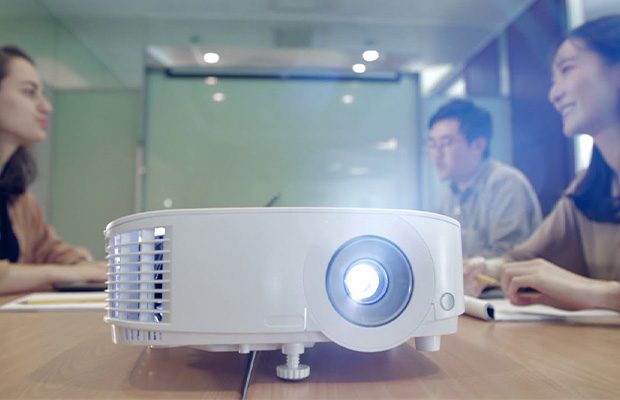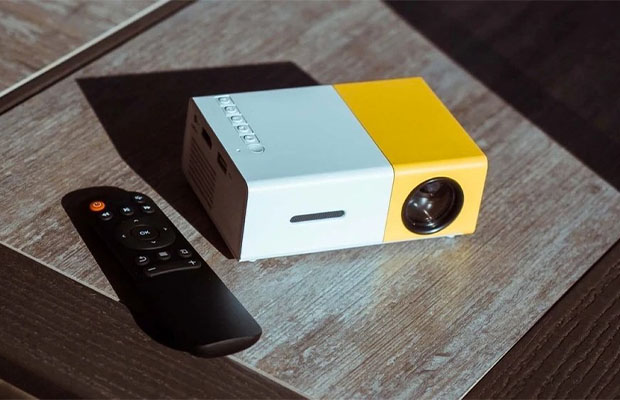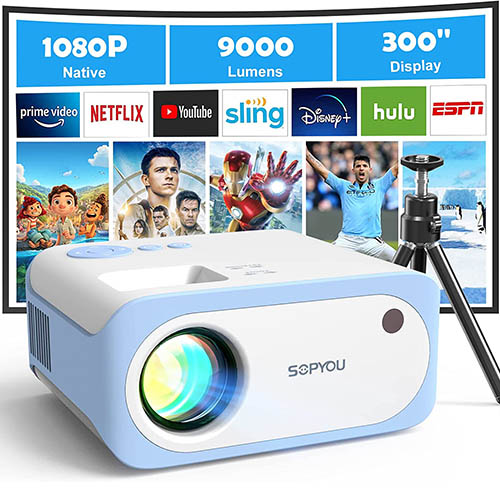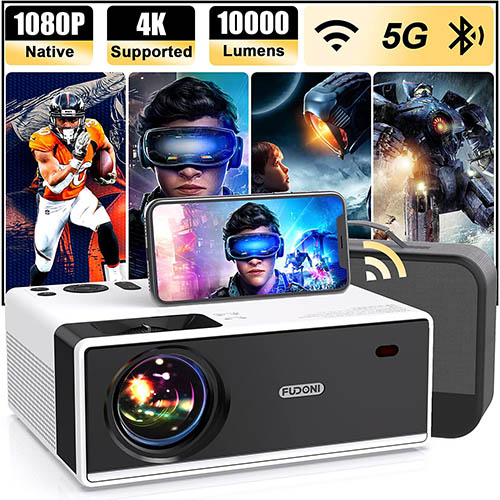With color and detail that is sure to garner praise from both friends and family, the BenQ W500 projector elevates home theater entertainment to an entirely new level. The color isn’t perfect, and the 1.2x zoom range makes placement flexibility limited.
This projector will turn your house into the most sought-after ticket in town thanks to its 1100 lumens and the vivid realism of 3LCD technology. The BenQ W500 projector’s main advantages are its low asking price and $250 replacement lamps, which can make it a desirable, cost-effective choice.
If you’re thinking about buying one, read our review; it covers all the essential details.
Read More: Bold Projector Review
Table of Contents
Specifications Of BenQ W500 Projector
- ANSI lumens: 1100
- (Full on/off) contrast: 5,000:1
- Light Engine: 1280 x 720, native 16:9, three-panel 0.6″ LCD with 140W lamp.
- Video Compatibility: 1080p/60/50/24, 1080i, 720p, 576p, 576i, 480p, 480i. NTSC/PAL/SECAM.
- Connection Panel: One HDMI port, one VGA port, two sets of component inputs for YPbPr, composite video, s-video, USB, one 12v trigger, and an RS232 port for external control.
- Throw Distance and Lens: 1.2x manual zoom/focus lens with vertical and horizontal lens shift. throws a 100″ diagonal, 16:9 image from 10’10” to 13′.
- Lamp Life: 2000 hours, 3000 in eco-mode
- Price of a replacement lamp: $250 street.
- Warranty: One year.
BenQ W500 Projector Highlights
- Good “out of the box” image quality, requiring minor adjustment, but problems with redshift in dark areas
- Very good brightness in “best” (Cinema) mode
- Good black levels and dynamic iris provides significant improvement
- Offers vertical and horizontal lens shift for placement flexibility
- Uses HQV (Hollywood Quality Video) circuitry for rich color handling
- Shadow detail is very limited
- Color uneven across the image
- Good color management system
- MAP (minimum advertised price) of $999
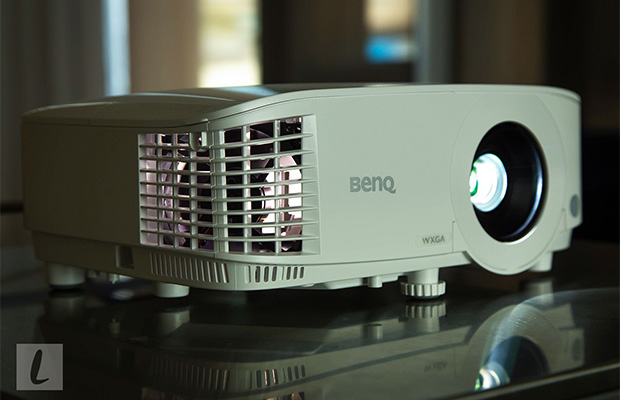
Overview Of BenQ W500 Projector
The Optoma and Mitsubishi DLP home theater projectors currently dominate the market for entry-level (MAP price under $1000) 720p front projectors, so I was happy to take a close look at the BenQ W500, a third affordable home theater projector (this one uses 3LCD technology), for customers to choose from. The W500 is an LCD projector, which astounded me to learn. Be aware that up until now, BenQ has only offered DLP technology and that this is the company’s first LCD home theater projector.
The BenQ W500’s adjustable vertical and horizontal lens shift, which enables the projector to be positioned vertically anywhere between 55% (of screen height) above and 55% below the center of the screen, is the most significant difference between it and the Mitsubishi HC1500, Optoma HD70, and other projectors (aside from the technology inside). The two competitors who offer fixed lens shifts have a significant offset, so they must be placed either above the top or below the bottom of the screen. In particular, for shelf mounting, this gives the BenQ an advantage in flexibility. For those looking to ceiling mount in a room with low ceilings—rooms less than 8 feet from floor to ceiling—the large lens offset of the other two tends to be a serious issue.
Pros Of BenQ W500 Projector
With the lens offset to one side and a heat exhaust vent on the other, the BenQ W500 is housed in a glossy white case. Not only will the white case match your ceiling, but the front exhaust also qualifies the W500 for mounting on a rear shelf or coffee table. The projector’s connection panel is located on the back, while the lens bezel and top-mounted control panel are both accented in silver.
When it comes to lumen output, the W500 is no pushover. With a fantastic 93% uniformity of brightness, our test unit measured a maximum of 731 ANSI lumens. In low lamp mode, lumen output decreased 14% to 629 ANSI lumens, which is a smaller decrease than on most competing devices. These readings were obtained using the Dynamic image mode with the color temperature set to “lamp native.””
The Dynamic setting is excellent for sporting events or projection in natural light, but it is too bright to use in a darkened home theater. With the lamp on low and the color temperature set to “normal,” Cinema mode generated 333 ANSI lumens for rooms with more traditional decor.” For those who have larger screens, using Dynamic image mode and setting the color temperature to “normal” will result in about 470 ANSI lumens, which should be sufficient to comfortably illuminate a 120″ diagonal screen in a space with adequate light control.
The W500 has excellent image sharpness. Despite being compressed to 720p, HD 1080p content displays image detail with accuracy, and SD content does not experience any significant degradation. Image clarity is exceptional for a projector that costs so little.
The W500’s ability to shift lenses horizontally and vertically is one of its most distinctive features. The W500’s image placement options include completely above or completely below the lens centerline, for a total vertical range of just over two screen heights. The image can be shifted horizontally in either direction by a third of its width. This makes the W500 very adaptable in terms of mounting; it can be placed on a coffee table or the ceiling with ease, and a rear shelf mount is possible with some skill.
Unlike earlier BenQ projectors, the W500 has a new menu structure. This new menu features a fantastic system for adjusting color—the user can change hue and saturation for both the primary and secondary colors. The W500 also has three user-programmable image modes that are persistent across all inputs, so no matter what source you have plugged in, the settings will remain the same.
The remote control is sturdy and has a powerful backlight. The functions of each button are printed on the button itself, making it simple to use the remote in the dark. It is virtually impossible to accidentally press a different button because the backlight activation button is at the bottom of the remote, set off by itself.
Standard definition content appears as clear as it has ever looked thanks to Silicon Optix’s HQV processor, which was integrated into the W500. Deinterlacing artifacts are virtually nonexistent, while scaling is clean and clear. The precision of its deinterlacing and scaling, as well as the almost complete absence of digital noise, consistently put BenQ ahead of its rivals in side-by-side testing.
Replacement lamps for the W500 cost a mere $250. The BenQ W500’s operating costs are reduced to just 8.3 cents per hour, assuming a full 3,000 hours of lamp life. It would be rude to refer to that sum as pocket change. While the projector needs to be removed from the ceiling in order to replace the lamp, it doesn’t need to be removed in order to clean the dust filter; just slide it out toward the front of the case. You will no longer have an excuse for failing to clean the projector’s filter.
Cons Of BenQ W500 Projector
It was a bit of a shock to see a pixel structure after being spoiled by many 1080p projectors this fall. The W500 has clearly visible pixelation when seated closer than 1.6 times the screen width. When organizing the seating in your theater, keep in mind that occasionally, visible pixelation can be distracting.
The W500 can display a 100″ diagonal 16:9 image between 10’10” and 13′ depending on zoom with a 1.2:1 zoom range. This indicates that the projector will typically be mounted slightly behind or directly above the audience given the visible pixelation described above. The 1.2:1 zoom range on the W500 is a notable limitation when compared to the extensive 2.0:1 zoom ranges found on LCD projectors priced at only $300 more.
Rated at 5000:1, the on/off contrast. The contrast was decidedly subpar right out of the box; the blacks were quite deep, but the shadow detail was frequently lacking. The W500’s menu system allows users to adjust the “Black Level,” which is pre-configured at 7.5IRE. Some footage suffered a severe loss of shadow detail as a result of this setting. You can partially restore the lost shadow detail without making too many black-level sacrifices by changing this setting to 0 IRE and reducing Brightness a few notches.
BenQ W500 Projector Vs. Mitsubishi HC1500
While it may seem like an apples-to-oranges comparison, we put the BenQ W500 up against the Mitsubishi HC1500, successor to the venerable HD1000U which helped pioneer 720p projection under $1000.
In its brightest operating modes, the HC1500 is, like the Cinema 400, significantly brighter than the W500. The HC1500 measures up to 800 ANSI lumens in Cinema mode, and can easily be made brighter; meanwhile, In Cinema mode, BenQ measures closer to 300 ANSI and has an absolute maximum of 730 ANSI. In addition, the color and black levels on the HC1500 are deeper and more vibrantly balanced. As a result, the HC1500’s image is more realistic, film-like, and interesting than the W500’s.
Although there are not as many differences between the HC1500 and W500, the W500 still outperforms the HC1500 in terms of image processing. Despite the fact that both projectors have a 1.2:1 manual zoom lens, the W500 offers greater placement flexibility because the HC1500 lacks a lens shift feature.
If the Mitsubishi HC1500 will work with your viewing setup, we still heartily recommend it. If that’s not possible, the W500’s increased flexibility can lessen the pain of a projector that was not placed perfectly.
Conclusion
The BenQ W500 is an intriguing blend of high-end and low-cost. It is a fantastic low-cost option for playing video games, watching sports, and watching HDTV because of its high lumen output and excellent image processing circuitry.
Considering all its features, we would say BenQ W500 Projector is a good choice.

